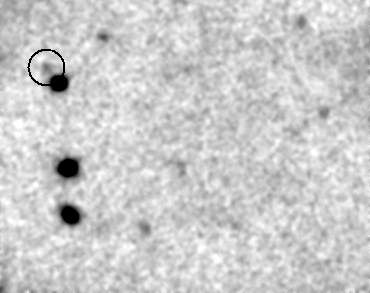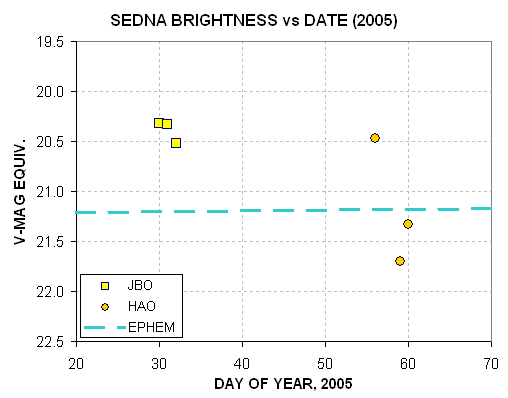

Sedna is a trans-Neptunian Object, or TNO. It is currently 90 A.U. from the sun, and it ranges from 76 to 900 A.U. during its 10,500 year orbit. It was discovered in November, 2003.
Few amateurs have imaged Sedna because it is so faint. It's present
magnitude is 21.2, according to the JPL Ephemeris. It's diameter is
estimated to be 800 to 1100 miles. It's reddish color resembles that of
asteroids.
Local amateur astronomer Dave Healy obtained images of Sedna January
30, 31 and Februuary 1, 2005. My analysis of his unfiltered images
yield Mc = 20.32, 20.66 and 20.52, with stochastic uncertainties of
~0.03
for the last two images. He used a 32-inch Ritchie-Chritien telescope
at his Junk Bond Observatory.
My interest in Sedna is prompted by a desire to measure its "rotation light curve." I shall record my observations, and any that Dave Healy wishes to include here, for this purpose.
Here are images of Sedna made February 28 and March 4, 2005 UT, showing its motion during a 4-day interval.


Figure 1. Sedna (circled) on two dates, 2005 February 28
and 2005 March 4 UT. Each image has a FOV = 3.0 x 2.3 'arc, and
represents a 1.7% areal crop of the original images (24.7 x 16.5 'arc).
North is up, east to the left. Sedna's apparent motion during this
4-day interval was 1.45 'arc. The first image was made by stacking 70
2-minute exposures, and the second image was made by stacking 25
5-minute exposures (using median combine for groups of 4, etc).
Therefore, the total exposure times are 140 minutes and 125 minutes. Sedna's
unfiltered
V-equivalent magnitudes are 21.70 +/- 0.10 and 21.33 +/- 0.10
(based on a nearby star calibrated by Brian Skiff). The
uncertainties are stochastic (based on SNR =10 and 10). Limiting
magnitudes are 22.8 and 22.9. [Celestron CGE-1400, Cassegrain, focal
reducer
yielding system f/8.96, AO-7 tip/tilt image stabilizer, SBIG CFW-8,
SBIG ST-8XE CCD; "Hereford Arizona Observatory" (G95),
Hereford, AZ; 4560 feet ASL]
Sedna's locations are close to the JPL Ephemeris predctions.
For the first image the measured position is 0.6 "arc (west) and 0.0
"arc north of the predicted location, and for the second image the
measured position is 0.07 "arc noirth and 0.15 "arc west of the JPL
Ephemeris predicted position. For the first image the
individual 2-minute exposures had FWHM that were typically 4.0 "arc,
and after stacking 70 such images the FWHM was ~4.9 "arc. The second
image is made from 5-minute exposures with 4.6 "arc FWHM, that change
to 5.1 "arc FWHM after averaging.
An earlier image was made 2005.02.25, and Sedna appeared brighter
then, with Mc = 20.47 +/- 0.10 SEstochastic.
Here's a table of Sedna unfiltered V-equivalent magnitudes that have
been made, so far, by the two amateur observers Dave Healy and Bruce
Gary.
Table of Sedna Brightness Measurements
JBO = Junk Bond Observatory (Dave Healy; HAO =
Hereford Arizona Observatory (Bruce Gary)
|
OBSERVATORY |
DATE YYYYMMDD |
V-MAG
EQUIV |
SE
STOCHASTIC |
| JBO |
2005.01.30 |
20.32 |
0.13 |
| JBO |
2005.01.31 |
20.66 |
0.03 |
| JBO |
2005.02.01 |
20.52 |
0.03 |
| HAO |
2005.02.25 |
20.47 |
0.10 |
| HAO |
2005.02.28 |
21.70 |
0.10 |
| HAO |
2005.03.04 |
21.33 |
0.10 |

____________________________________________________________________
This site opened: March 01, 2005. Last Update: March 04, 2005